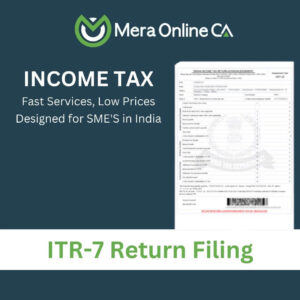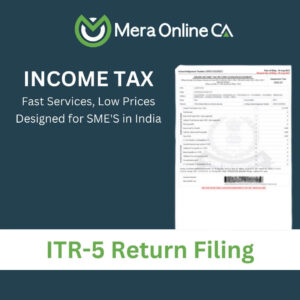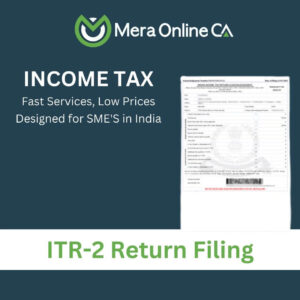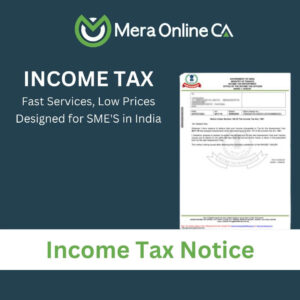ITR 1 Filing Form
The Income Tax Department has categorized the taxpayers into the group to ease the tax compliances this categorization is done based on the income and the sources of the income. ITR 1 Return filing in India is for people with an income of up to Rs.50 lakh.
This article is a comprehensive guide to understand the ITR 1 Sahaj Form. Each category of the taxpayer has to compute the taxable income as it is laid down in the Income Tax Act,1961. Post computation it is necessary for the taxpayer to file the Income Tax Returns.
Who can file ITR 1 Sahaj Form?
ITR 1 Sahaj Form is for individuals that have income up to Rs.50 lakh lakhs. The individuals earning income from the following sources can file ITR 1 Sahaj Form:
- Salaried person- Salary refers to the remuneration or consideration that a person receives for the services he or she has to render under the contract of employment. The Income Tax Act,1961 includes the following under the salary income
- Wages
- Pension
- Annuity
- Advance salary paid
- Leave Encashment
- Fee, prerequisites, commission, profits besides or in lieu id the salary or wages
- Transferred balance in recognized provident fund
- Annual accretion to the recognized provident fund
- Central Government contribution or an employer contribution to Pension account as mentioned in Section 80 CCD of the Income Tax Act.
- One house property: If the taxpayer is the owner of a property from which he or she is earning rent, the rent proceeds become taxable.
- However, if the taxpayer is using the owner of a property from which he or she is earning rent, the rent proceeds become taxable. However, if the taxpayer is using the property for running some business or profession the same would be taxable under the heading “Income from business or profession”.
- Other sources (does not include income earned from winning lottery or racehorses)
- Agricultural income (Upto to Rs. 5000)
Who cannot file ITR 1 Sahaj Form?
ITR 1 Sahaj Form cannot be filed by the following:
An individual with an income of more than Rs.50 lakh cannot use this ITR 1 Sahaj 1 Form.
An individual who is a Director of a Company and has held unlisted equity shares during the financial years cannot use this form.
Residents who are not ordinary residents and non-residents also cannot file ITR 1 Sahaj Form.
Individuals who earned income through the following sources cannot file ITR 1 :
Documents required to file ITR 1 Sahaj Form
What documents are required to file ITR 1 Sahaj Form?
The income Tax rate under the Existing Tax Regime and the New Tax Regime ( For TDS return Filing)
The taxpayers now have an option to choose between the old and the new tax regimes. The decision of opting for a tax regime has to be taken at the beginning of the financial year.
The income tax rates according to the old tax regime are:
For individuals up to the age of 60 years
| Taxable Income | Income Tax Rate |
|---|---|
| Up to INR 2,50,000 | Nil |
| INR 2,50,000 – INR5,00,000 | 5% |
| INR 5,00,000 – INR 10,00,000 | 20% |
| Above INR 10,00,000 | 30% |
For individuals aged between 60-80 years (Senior Citizen)
| Taxable Income | Income Tax Rate |
|---|---|
| Up to INR 3,00,000 | Nil |
| INR 3,00,000 – INR5,00,000 | 5% |
| INR 5,00,000 – INR 10,00,000 | 20% |
| Above INR 10,00,000 | 30% |
For individuals above the age of 80 years ( Super senior citizens)
| Taxable Income | Income Tax Rate |
|---|---|
| Up to INR 5,00,000 | Nil |
| INR 5,00,000 – INR 10,00,000 | 20% |
| Above INR 10,00,000 | 30% |
The new tax regime is where the taxpayer has an option to choose either to pay taxes at a lower interest rate as per the new tax regime on the condition that they forgo certain permissible exemptions and deductions that are available the income tax.
or
The taxpayer can continue paying taxes under the existing tax rates. The assessee can avail of the rebates and the exemption by staying in the old regime and pay taxes at the existing high rates.
The income tax rates under the new tax regimes that is applicable for individuals and the HUFs is as follows:
| Income Slab | New regime tax slab rate(Applicable for all individuals and HUF) |
|---|---|
| Up to INR 2,50,000 | NIL |
| INR 2,50,000 – 3,00,000 | 5% (Tax rebate u/s 87 a is available) |
| INR 3,00,000 – 5,00,000 | |
| INR 5,00,000 – 7,50,000 | 10% |
| INR 7,50,000 – 10,00,000 | 15% |
| INR 10,00,000 – 12,50,000 | 20% |
| INR 12,50,000 – 15,00,000 | 25% |
| More than INR 15,00,000 | 30% |
Note:
The tax rates in the New Tax regime are the same for all categories of individuals. Hence, there is no increased basic exemption limit benefit that will be available to the senior and the super senior citizens in the New Tax Regime.
Individuals with Net Taxable Income less than or equal to Rs 5 lakh will be eligible for the tax rebate u/s 87 A the tax liability will be Nil for such individuals in both New and Old existing tax regimes.
The exemption limit for NRIs is Rs. 2.5 lakh irrespective of age.
Additional health and education cess at the rate of 4% will be added to the Income-tax liability in all cases ( Increased from 3% since FY 2018-19)
An applicable surcharge as per tax rates below in all categories mentioned above:
- 10% of the income tax if total income > Rs. 50 lakh.
- 15% of the income tax if the total income > Rs.1 crore
- 25% of the income tax if the total income > Rs.2 crore.
- 37% of the income tax is the total income > Rs.5 crore.
What are the conditions to opt for a new tax regime?
The taxpayer opting for concessional rates in the new tax regimes has to forgo the exemptions and the deduction that is available under the old tax regime. In total 70 deductions are allowed out of which the most commonly used are listed below:
The list of common exemptions and deductions that are not allowed in the new Income tax regime are:
List of common deductions allowed the New Tax Regime
Major Amendments to ITR 1 filing for the AY 2021-2022
The following changes are incorporated in the ITR Form:






1. Who can File ITR 1?
08 December 2021
ITR 1 can be used by individuals who is a resident of India for tax purposes only. Also, all the taxpayers with income only under any or all three heads of income that includes Salaries, Income from House Property, and Income from other sources are eligible to file ITR 1.
2. How to file ITR 1?
08 December 2021
ITR 1 can be filed both offline as well online.
3. While filing ITR 1 is it necessary to show the interest income from other sources if the TDS is already deducted?
08 December 2021
Yes, it is necessary to include interest income from other sources even if the tax is deducted by the bank.
4. How to file ITR 1 returns offline?
08 December 2021
ITR 1 returns can be filed offline: By furnishing a return in Physical Paper form after which an acknowledgment is issued at the time of submission of the physical paper return.
5. How to file ITR 1 returns online?
08 December 2021
ITR 1 returns can be filed online by transmitting the data electronically and then by submitting the verification of the return in Form ITR V to the CPC Bengaluru. By making the return filing online and then e-verifying the ITR V through net banking/Aadhar OTP/EVC. If the ITR 1 is submitted electronically then the acknowledgment will be sent to the registered via email. Also, it can be downloaded from the income tax website then sign and send to the income tax department’s CPC office in Bangalore within 120 days of e-filing.
6. Is ITR 1 an annexure less form?
08 December 2021
ITR 1 form is an annexure less return, there is no need to attach any documents such as Form 16 or Form 26 AS with the ITR 1 form.